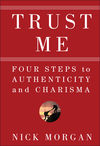Today, I spoke with Dr. Nick Morgan, who is one of America’s top communication theorists and coaches and author of a new book called Trust Me. Nick discusses how online and offline communication differs and how your mistakes are easily viewable online. He then tells you how to find your inner voice when communicating, a solution to when words and body language don’t get along and tips on how to become a better communicator.
How do online and offline communication skills differ? What do people need to be more conscious of online?
The difference between online and offline communication skills is huge. There are 2 main issues to keep in mind.
- Online, you’re missing a whole stream of information — non-verbal communication, or body language — that provides context, attitude, emotion, authenticity, charisma, and so on and that we ‘read’ unconsciously when we’re in someone’s presence. Without that information, online we look to the words and emoticons to give us a bit of these things. So you need to be very aware of the tone you’re projecting in what you’re writing. Everyone has horror stories about misunderstood emails that were intended as jokes, for example, and that caused no end of problems.
- For applications like Facebook and other social media, the information you put up is usually visible for all to see and is available essentially forever. When 2 people are talking in person, a gesture comes and goes in a nanosecond. But a picture online of you doing something drunken and disorderly is there for potential employers to see for as long as the site is up.
Trust and authenticity are big issues for all of us in person. They are much more fragile — hard to establish and hard to keep — online. Treat them with great care.
How does one embrace their own personal speaking style? What if people have trouble finding their inner voice?
As I explain in my book, Trust Me: Four Steps to Authenticity and Charisma, every communication is 2 conversations, the content and the body language. When the 2 are aligned, you can be an effective communicator. When they’re not aligned, people believe the non-verbal every time. So it’s essential to get clear on your own emotional attitudes toward what you’re speaking about, because that’s what is going to come out when you speak. You find your own personal speaking style by doing the hard work of looking deep within yourself, focusing on your emotional attitudes, and aligning them with what you want to say. If you’re having trouble doing that, it’s usually because there is a mismatch between message and attitude. That’s the place to look to begin to solve the problem.
What happens when words and body language are in conflict? Who wins and why?
We all look to body language unconsciously to decide whether or not people are being real, passionate, and authentic, or the opposite of those things. We are all experts at unconsciously decoding body language. We’re not very good at doing that consciously, but we’re unconscious experts. Recent brain research shows that we do this decoding nanoseconds before we have conscious thoughts about the other people
So body language always wins. It happens first, it’s decoded first, and it’s far more powerful than words. Here’s an example that will make it clear. Imagine a strange-looking person — the next speaker — shuffling up to the front of the room very slowly. He’s bent over, and doesn’t make eye contact. When he finally gets to the front of the room, he speaks in a barely audible, high, nasal voice, saying, “I’m really glad to be here today.” Which do you believe? You’re reaching for your Blackberry, right? Or heading for the exit?
What is your 4-step communication process?
You first have to get your body language to be open. You do this by focusing on your emotions, and imagining a scenario where you would be open — say, talking to your spouse, your partner, or a close friend — and then recapturing that body language for your speech. That’s step one. Step two is to connect to the audience. Once again, you do this by forming the intent to connect. You might imagine, for example, that your spouse is distracted and not hearing you. What would you do to get his or her attention? You might move closer, raise your voice, establish eye contact, even touch the other person on the arm. All of those gestures and actions, used appropriately, will help you connect. Third, you focus on the emotional attitude you have toward the content. And fourth, you focus on the audience — how it is receiving your material.
What I tell clients is to practice your speech at least 3 times, the first time focusing on being open, the second time on being connected, and the third time on your emotional connection to the material. Then, when you’re ready to deliver it, you should have both the content and the body language down well enough to be able to pay attention with, say, 10 % of your brain, to the audience. Having a speaker that is capable of truly paying attention to the audience is very charismatic for that audience.
There’s more to the process, but that’s the high-level idea.
What are your top 3 tips for being a better communicator when presenting to a large audience?
- Rehearse in the space. So many times I have seen speakers fail because they weren’t familiar with the room
 and didn’t anticipate that the lights would be so bright, or the sound system is unfamiliar, or the shape of the room makes it hard to move, and so on.
and didn’t anticipate that the lights would be so bright, or the sound system is unfamiliar, or the shape of the room makes it hard to move, and so on. - Know your material so well that you can focus on the audience. Joy in public speaking comes when you have the big Zen insight that it isn’t about you, it’s about the audience. If they don’t get it, no communication has happened. So let go of your own concerns and focus on the them. To be able to do that, you have to know your speech cold.
- When the audience gets to be about 500 or more people, slow down and keep it simple. Large audience want to participate in ‘call and response’ with a speaker, and they want to have fun. Don’t fight it. Let the audience do the work!
——-
Dr. Nick Morgan is one of America’s top communication theorists and coaches. A passionate teacher, he is committed to helping people find clarity in their thinking and ideas — and then delivering them with panache. He has been commissioned by Fortune 50 companies to write for many CEOs and presidents. He has coached people to give Congressional testimony, to appear on the Today Show, and to take on the investment community. His latest book is Trust Me: Four Steps to Authenticity and Charisma, published in December 2008 by Jossey-Bass. His acclaimed book on public speaking, Working the Room: How to Move People to Action through Audience-Centered Speaking.







